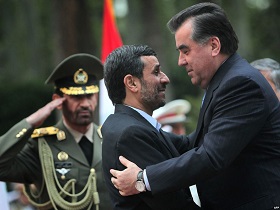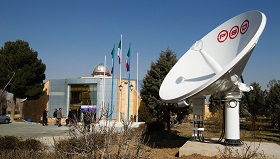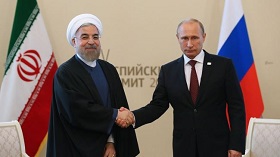In Search of Support Points: Iran in Central Asia
Hassan Rouhani, President of Iran
In
Login if you are already registered
(votes: 1, rating: 5) |
(1 vote) |
Doctor of History, Head of Center for the Middle East Studies of the IMEMO, Professor of the Oriental Studies Department of the MGIMO University, Senior Research Fellow at the Center for Arab and Islamic Studies of the Institute of Oriental Studiesof the Russian Academy of Sciences, RIAC Member
Iran occupies an important place in Central Asia’s system of political and economic relations. It may not boast impressive resources such as those of Central Asian countries’ leading partners (China, Russia, the EU), and faces substantial political restraints due to the current sanctions regime, but despite this, Iran has managed to secure a prominent presence in the region.
Iran occupies an important place in Central Asia’s system of political and economic relations. It may not boast impressive resources such as those of Central Asian countries’ leading partners (China, Russia, the EU), and faces substantial political restraints due to the current sanctions regime, but despite this, Iran has managed to secure a prominent presence in the region.
Iran's interests in Central Asia
On the one hand, Central Asian states’ independence opened up a pathway for them to the globalized world, and on the other, it provided outside actors an opportunity to expand their sphere of influence in the new region and benefit from establishing trade and economic ties. Iran is no exception, and, perhaps, pinned even greater hopes on strengthening its positions in Central Asia than other countries of the Middle East. Against the background of strained relations with the Arab world, tensions and disagreements with the West, generated by the Islamic revolution, for Iran, a breakthrough in Central Asia meant a chance to recoup the damages incurred through by winning new friends and partners, and by strengthening trade and economic ties. In the early 1990s, Iran intensified its activity in the region, with an emphasis on its ethnic and linguistic affinity with the culturally close Tajikistan. However, the Central Asian geography of its ties later went beyond this narrow scope and now includes all states in the region. Iran is a welcome player in Central Asia – it helps solve transport and energy problems, provides technologies, develops trade relations, has influence in the Economic Cooperation Organization (ECO), the Organization of Islamic Cooperation (OIC), and the Organization of Petroleum Exporting Countries (OPEC).
In the early 1990s, Iran intensified its activity in the region, with an emphasis on its ethnic and linguistic affinity with the culturally close Tajikistan. However, the Central Asian geography of its ties later went beyond this narrow scope and now includes all states in the region.

Mahmoud Ahmadinejad and Emomalii
Rahmon, Tehran, March 26, 2010
Strengthened positions in Central Asia gives Iran an opportunity to attain a number of related goals.
The first one is overcoming isolation. Attaining this goal will improve Iran’s international image. Moreover, in contrast to the Middle East, which perceives Iran's policy of strengthening its positions as an attempt to exert a decisive military and political influence on the situation, in Central Asia, Iran has traditionally pursued a well-thought out policy that was virtually flawless in terms of politics. This allowed the country to develop relations (albeit to different extents) with all the Central Asian states, who view Iran as an independent and influential actor in the region. Cooperation with Iran gives them additional opportunities for diversifying their external relations, and fits well into the multi-vector policy that allows balancing among the various centers of power.
In Central Asia, Iran has established relations with the new states, whose international positions are quite important for the country. Some experts say that Iran’s diplomacy in Central Asia is focused on the gradual penetration of all areas that could eventually contribute to overcoming the country’s foreign policy and economic isolation. Iran has positioned itself as a reliable partner pursuing parallel interests to those of the world’s leading countries. It has a pragmatic interest in laying the foundations for future strength and rapid breakthroughs once sanctions are lifted or dramatically eased.
Central Asia is less religiously motivated in its actions than the leading countries in the Middle East (the vast majority of the Muslim population of the region is Sunni [1]). In Central Asia, Iran has no a priori claim to leadership and is guided by pragmatic interests, rather than values. Iran’s policy in Central Asia has always been rational and restrained. It has not been affected much by the change in leaders and has displayed neither confrontation nor sudden swings. During the civil war in Tajikistan, Iran, which sympathized with the Islamic opposition, backed a political settlement on the basis of power-sharing.
In contrast to the Middle East, which perceives Iran's policy of strengthening its positions as an attempt to exert a decisive military and political influence on the situation, in Central Asia, Iran has traditionally pursued a well-thought out policy that was virtually flawless in terms of politics.
In general, Iran's policy in Central Asia seems acceptable even for those external forces that exert pressure on it in other spheres of the Republic’s political-military activities.
The second objective is to derive real economic benefits from trade and economic cooperation.
In this regard, Iran and the Central Asian states have common interests. For example, Iran has built the Tejen-Sarahs-Mashhad railway line, providing Central Asian states with access to the ports of the Persian Gulf, the markets of the Middle East, South and Southeast Asia, which have become an important source of foreign exchange earnings for Turkmenistan. There are even more ambitious projects, such as plans to link the North-South Transport Corridor from Kazakhstan through Turkmenistan to Iran’s Golestan Province via the Iranian railway network, opening the way to the ports of the Persian Gulf. In future, this facility is expected to transport up to 12 million tons of cargo annually.

Iran has built the Tejen-Sarahs-Mashhad railway
line, providing Central Asian states with access
to the ports of the Persian Gulf, the markets of
the Middle East, South and Southeast Asia,
which have become an important source of
foreign exchange earnings for Turkmenistan
The countries of the region consider communications infrastructure construction a key element in diversifying transport routes. Iran is involved in building hydropower plants and pipelines, and plans to lay a power line from its border through Herat, Mazar-i-Sharif, up to the borders of Tajikistan. Tajikistan occupies a particular place in relations between Iran and the Central Asian states, which is due not so much to economic and political considerations, but to ethnic and cultural affinity. In contrast to the Turkic peoples that dominate the region, the Tajiks together and Iranians belong to the Indo-European linguistic family. Throughout its independence, Kazakhstan has become Iran's largest trading partner in the region, with the swap-based system of oil supplies [2]. Ties with Turkmenistan are stable and dynamic. Experts estimate that, in 2012, Iran was Turkmenistan’s third largest trading partner (after China and Russia).
Cooperation with Iran in the gas sector is particularly important to Turkmenistan. In 1997, the Korpeje–Kordkuy natural gas pipeline was built, with a capacity of 8 billion cubic meters per year, and in 2010 the Dovletabad-Sarahs-Hangeran pipeline was commissioned, with an expected capacity of 12.5 billion cubic meters of gas per year [3]. These pipelines are mainly Iran-oriented, but it is entirely possible that in the future, when Iran’s political and economic situation improves, it will break Russia's transit monopoly and provide gas supplies to different markets.
Iran's policy in Central Asia seems acceptable even for those external forces that exert pressure on it in other spheres of the Republic’s political-military activities.
However, Iran has failed to build a dynamic relationship with all the countries of the region. The limiting aspects in Iran-Uzbek relations were initially associated with the American vector of Uzbekistan’s foreign policy. However, the gradual lifting of sanctions and Iran's attempts to improve relations with the West and to reintegrate the country into the global economy weakened this factor, and made Tashkent less ideologically circumspect of Iran. However, Uzbekistan still fears that the construction of hydropower plants in Tajikistan could reduce the inflow of water resources to the country, leading to water resource management and increased water discharge in winter and the accumulation of water in reservoirs in summer. Uzbekistan is particularly concerned by the construction of the Sangtuda 2 Hydroelectric Power Plant in Tajikistan, in which Iran is involved.
Iran has failed to promote the further development of relations with Kyrgyzstan, where other players, especially Russia and China, are active and successful.
In addition to objective difficulties in export-import transactions, economic relations between Iran and Central Asian states also face subjective difficulties (see Tables 1, 2). These are largely due to Iran’s international isolation and excessive bureaucracy. Thus, there is a lack of an established Iranian banking system in Central Asia (apart from Kazakhstan), which complicates servicing commercial operations.
Table 1.Exports of Central Asian countries in 2010
| Country | Exports volume, billion USD | Share of exports volume, % |
|---|---|---|
| EC | 31,9 | 37,7 |
| Russia | 13,8 | 16,4 |
| China | 12,4 | 14,6 |
| Iran | 4,0 | 4,8 |
| Turkey | 2,7 | 3,1 |
| Switzerland | 1,7 | 2,0 |
| USA | 1,1 | 1,3 |
Source : R. Mogilevsky. Trends and Patterns of Foreign Trade in Central Asia. University of Central Asia. Institute of Public Administration and Policy. Report # 1. Bishkek, 2012. p. 32 (http://www.ucentralasia.org/downloads/UCA-Trends&PatternsForeignTradeCA-Rus.pdf)
Table 2.Imports of Central Asian countries in 2010
| Country | Imports volume, billion USD | Share of imports volume, % |
|---|---|---|
| Russia | 17,2 | 27,3 |
| EC | 11,1 | 17,5 |
| China | 6,8 | 10,7 |
| USA | 4,1 | 6,6 |
| Turkey | 2,5 | 4,0 |
| Republic of Korea | 2,2 | 3,5 |
| Pakistan | 1,9 | 3,1 |
| Iran | 1,8 | 2,8 |
Source : R. Mogilevsky. Trends and Patterns of Foreign Trade in Central Asia. University of Central Asia. Institute of Public Administration and Policy. Report #1. Bishkek, 2012. p. 33 (http://www.ucentralasia.org/downloads/UCA-Trends&PatternsForeignTradeCA-Rus.pdf
All things considered, Iran has managed to take a prominent place in Central Asia, which is becoming increasingly diversified and where actors with greater capabilities operate. In some areas, Iran has become the most important partner, due to its territorial proximity, infrastructure, and technological capabilities.
Russia and Iran in the region: allies or rivals?

Uzbekistan is particularly concerned by
the construction of the Sangtuda 2 Hydroelectric
Power Plant in Tajikistan, in which Iran is
involved.
Russia and Iran are both active in Central Asia, and have shared and competing interests. The presence of common threats draws the two countries together and prompts them to act in unison or take parallel courses.
This can be seen in counter-narcotics initiatives. Despite tough measures adopted by Iran, the number of drug addicts in the country has dramatically increased in recent years. The common border with Afghanistan, which is almost impossible to seal completely, increased production of drugs and trafficking all deal a serious blow to Iran's security. According to reports, the Iranian government annually allocates $50 million to combat drug trafficking, and has already invested more than $700 million in strengthening border security. Russia and Iran can cooperate intensively in this sphere and seek to involve other regional players. Islamic extremists operating in Central Asia also pose a common threat to Russia and Iran. The increased activity of extremists is likely to be fuelled by developments in the Middle East, including by players such as Islamic State and the situation in Afghanistan after the withdrawal of the main contingent of the American troops.
Russia and Iran share a common interest in maintaining stability in the region and preventing the formation of hostile alliances with external forces. It should be noted that Russian-Iranian cooperation on the Caspian issue promoted an agreement at the IV Caspian Summit at Astrakhan (Russia) on September 29, 2014 on the general principles of delimiting marine areas, seabed and subsoil, the mode of shipping and fishing as well as the inadmissibility of a foreign military presence in the Caspian Sea.
However, Iran has failed to build a dynamic relationship with all the countries of the region.
Iran's policy in Afghanistan that has long gone beyond the scope of only supporting ethnically close groups (the Tajiks and the Hazaras) and plays a positive role for Russia and Central Asia. The trade turnover between Iran and Afghanistan is $2 billion per year. Agreements on rebuilding and construction work on irrigation and water supply systems have been reached, and there is talk of further developing cooperation in the electric power industry and laying communication lines. Iran’s activity in Afghanistan objectively contributes to stabilizing the situation.
Joint actions within the SCO are also important: as an observer state, Iran shares the Organization’s approaches to the principles of economic cooperation and major international issues. Iran supports the establishment of the SCO Development Bank and participates in the Interbank Association, which, according to some observers, facilitates its involvement in specific regional projects.

Sergey Demidenko:
Russia — Iran Scientific and Technical
Cooperation: Is There Any?
Russia and Iran’s competing interests are due to the similarity of how their economies are structured and the prominent role played by exporting energy resources. Competition for their transportation routes and markets directly involving Central Asian states could give rise to tensions between Moscow and Tehran, especially with as sanctions on Iran are lifted or eased, in a context of steadily improving US-Iranian relations. Thus, the gas pipeline through Iran and Turkey, which complicates Russian-Turkish negotiations on South Stream’s passage via Turkey, could provide supply gas to Europe. The infrastructure to supply gas to India and Pakistan is almost ready to be commissioned, but political constraints related to sanctions against Iran remain.
In both cases, Central Asia’s energy resources can offer the region an alternative to Russian pipelines. Against the background of sanctions imposed on Russia and the European Union’s willingness to reduce dependence on gas supplies from Russia, Iran may seem quite an attractive alternative, despite the existing limiting factors, although admittedly not in the near future. Today Tehran’s struggle with Islamic State in Iraq and Syria, as well as its increased activity in addressing common threats, improves its image in the West.

Conference "Development of Strategic
Partnership between Russia and Iran"
organized by RIAC, the Center for Energy and
Security and Institute of Iran Eurasian Studies
The potential for cooperation between Russia and Iran in Central Asia, both on a bilateral basis and within the SCO, is impressive enough. The elements of competition do not undermine the good reasons for mutually beneficial collaboration, but rather highlight the issues that require further joint consideration.
* * *
Broadly, it can be concluded that Iran has managed to lay the groundwork for the further development of relations with the Central Asian states. Having used its objective advantages, it was able to occupy its own niche, becoming an important partner and expanding the ability of governments in the region to diversify their external economic and foreign-policy relations.
Will future be cloudless? The divergence of interests among Iranian, Russian and Central Asian energy producers is likely to take place, but is unlikely to provoke a conflict. If the tendency of Iran’s improving relations with the United States and other Western powers continues, there will be no grounds for spreading the conflict between them over Central Asia.
For Iran, relations with the states of Central Asia are chiefly an opportunity to weaken its political isolation. It is not fighting for economic leadership and does not position itself as a rival to Russia, China or the EU. New transport opportunities, technological products and investment that Iran can offer are unlikely to change the existing balance of power in the region.
1. The Isma'ilis living in the Gorno-Badakhshan Autonomous Region of Tajikistan are generally considered Shia. According to estimates made in the early 2000s, their population in Tajikistan did not exceed 400,000 (http://www.ca-c.org/journal/2003/journal_rus/cac-06/05.niyru.shtml)
2. For details see: E.M. Kuz'mina. Vneshnie ekonomicheskie interesy kak faktor ekonomicheskogo razvitia Central'noi Azii. (External economic interests as a factor in the economic development of Central Asia) Moscow, RAS Institute of Economics, 2013. pp. 33–38.
3. Ibid. p. 37
(votes: 1, rating: 5) |
(1 vote) |




